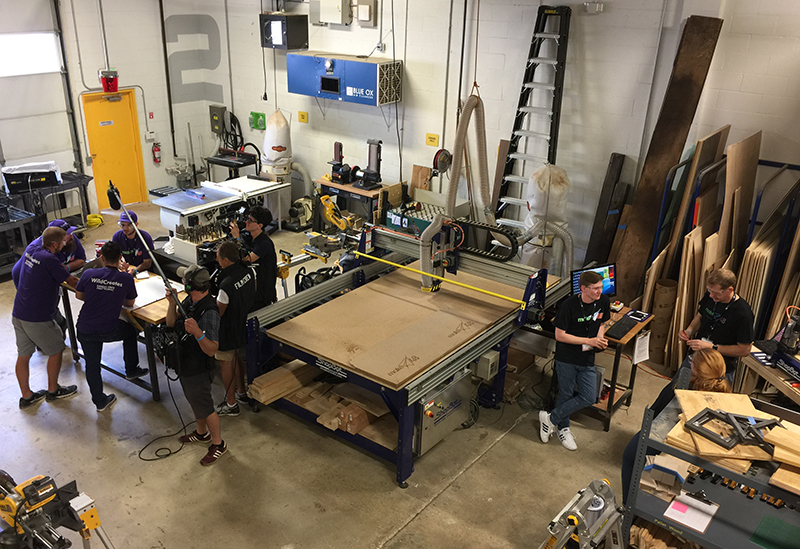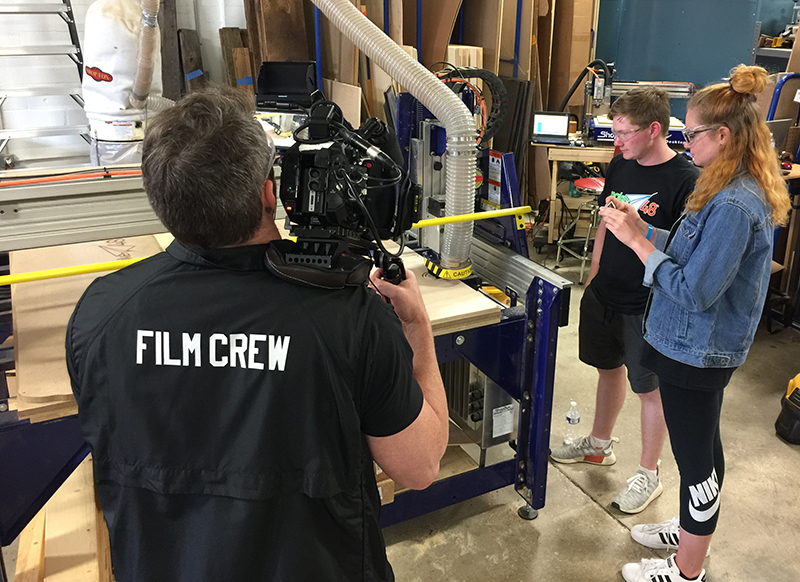
Make48 Film Crew at Work
As a product design student walking into an event where teams are tasked with designing a product, I didn’t quite know what to expect. Every day at school we brainstorm ideas, sketch them out, prototype them over and over, and then at the end of the project, market and present a finished prototype to our peers. As I looked around the empty shop in the quiet hours before the competition began, I wondered how closely what I was about to witness would resemble the process of product development that I had grown so familiar with. I was in Towson, Maryland at the Stanley Black & Decker Makerspace for Season 3 of the TV show “Make48” in which 48 contestants have 48 hours to develop a product, produce a working prototype, create a short promotional video for that product, present it to a panel of judges, and do it all within the given challenge category and specific budget constraints. Sounds easy enough, right? This year, the contestants were all college students from universities all over the country—but I wasn’t there as a contestant. I was invited as a tool tech for ShopBot Tools, there to help the teams realize their ideas through physical prototypes and to guide them through the process of 3D modeling and 2D vector design for CNC machining.
Once the contestants began to arrive and I had a chance to talk with them a little, it became apparent that the competition drew a heavily engineering-based crowd. Of course, there were outliers who didn’t fit into this category, and there was one team that didn’t have a single engineering or design-based member. Those were the teams I was most interested in following. Sometimes throwing people out of their element and having them do things they wouldn’t normally do can yield surprising and positive results.
Right before noon on Friday, we all gathered around the huge stop clock at the front of the room, eagerly waiting for the 48 hours of chaos to begin. The giant steam whistle blew loudly, like the start of a factory workday in days gone by. It’s then time for the teams to get down to business and time for the tool techs to stand at the ready once the prototyping begins. Straight out of the gate, each team tackled the brainstorming phase in different ways. Within the first two hours, one team had created a model and 3D printed a rough prototype while many other teams struggled to narrow down the category of products that they wanted to focus on. Some teams immediately turned to sketching out their thoughts, while others pulled their ideas together into ordered lists, and one team had a mess of notes scattered across the table with no rhyme nor reason. Unfortunately for me as a tool tech, I was merely a spectator in these first few hours as teams decided what they wanted to create. It wasn’t until they began thinking about prototyping that my expertise came into play. One-by-one, the teams began to send their members out to the tool techs to begin fabricating their ideas.

Cutting prototypes for the TV camera.
For me, that was when the most rewarding part of the whole weekend began; the first contestant came to us with their idea, and we helped them translate their idea into a real, tangible product. We worked with them to create or edit their CAD files and guide them through the process of converting those vectors into a ready-to-cut .sbp file. As the machine warmed up and we zeroed the axis to the new material, I watched the whole team gather around the tool. As the spindle began to cut away at the material, there was a visible change in their expressions as the magic of technology brought their vision into reality. Watching their faces light up with pride as they watched the ShopBot cutting out their product or their logo was rewarding.
If there’s one thing I’ve learned about design in my time at school, it’s that presentations matter. There were many rapid prototyping techniques available at this event to bring these teams’ projects to life. In addition to the two ShopBot CNC machines, there were twelve Ultimaker 3D printers, an Epilog laser cutter, a large vinyl cutter, a Bridgeport mill, and a CNC plasma cutter, as well as a well-stocked wood and metal shop filled with many Stanley Black & Decker power and hand tools. Although several universities represented have ShopBot tools in their programs, the teams unfamiliar with CNC technology found some machines intimidating. Once we cut out a few things on the ShopBot ourselves, you could see the curiosity and confidence in the faces of the contestants begin to grow as teams got excited about the potential of prototyping on CNC. On the last day, as I looked out on the stage as each team presented their products to the panel of judges, I admired all the work we’d done with the ShopBot. Without our ShopBot Desktop and large PRSalpha 5’x10’ gantry – or any of the other digital manufacturing machines – the outcome of this competition would have been very different, and certainly would have taken longer than 48 hours. In the world of design, an idea is nothing if you can’t see it through to a working product.
I really wish that I could tell you more about all the incredible products that the teams produced, but I’m not allowed to share that information until the show is released next year, so you’ll have to wait until then. For more on the show, including what channels the first two seasons can be viewed on, visit Make48.com.
Reported by Sarah Burns. Sarah is a third-year product design student at Appalachian State University in Boone, NC. She works at their Makerspace in the library where they have a ShopBot Desktop.







Leave a Reply